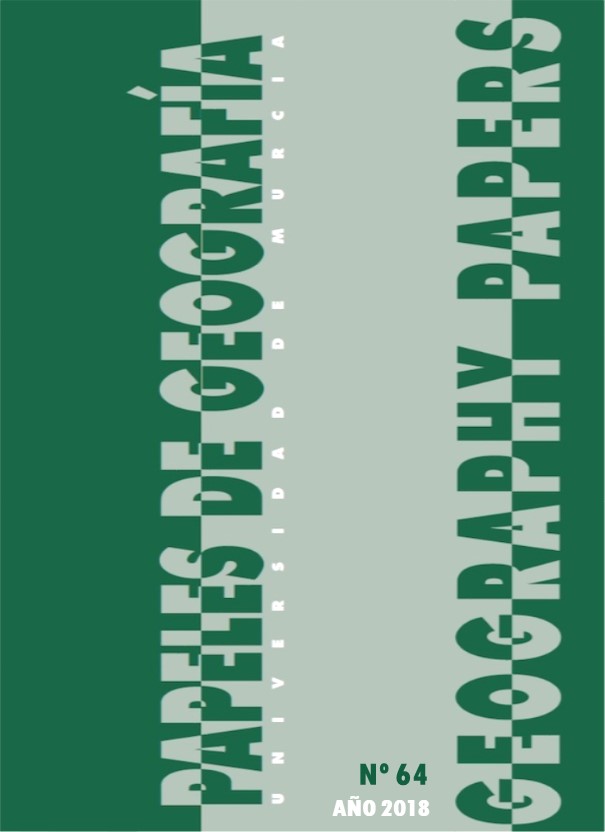Consecuencias del cambio climático en la disponibilidad de agua en el Sureste de la Península Ibérica. Evaluación del modelo hidrológico INVEST en escenarios futuros
Agencias de apoyo
- Universidad de Friburgo (Suiza)
Resumen
El sureste de la Península Ibérica se caracteriza por una trascendental escasez de agua, cada vez más agravada por los efectos del cambio climático. Para valorar sus consecuencias, se elaboró un análisis combinado de 30 cuencas mediante el modelo hidrológico del programa de evaluación de servicios ecosistémicos InVEST. La metodología empleada se basó en escenarios de concentración de gases de efecto invernadero, representados en niveles de fuerza de radiación de condición intermedia (RCP4.5) y extrema (RCP8.5); y proyectados para dos periodos, a corto plazo (2020-2050) y medio plazo (2070-2100). Los resultados mostraron unas tendencias de cambio en los escenarios analizados, con descensos promedio respecto a los registros actuales del 15% en precipitación, y aumentos promedio del 5% en la evapotranspiración de referencia. La reducción en la disponibilidad hídrica de las cuencas, proporcionaron tasas de variación negativas entre el 30 y 50% para los escenarios más realistas (RCP45 2050 y RCP45 2100). Los efectos en la disminución de los recursos hídricos debidos al cambio climático son evidentes, siendo necesarias soluciones urgentes relacionadas con la gestión del agua y sus demandas futuras.
Descargas
-
Resumen708
-
PDF588
Citas
ALCÓN, F., MARTÍN-ORTEGA, J., PEDRERO, F., ALARCÓN, J. J., y DE MIGUEL, M. D. (2013): "Incorporating Non-market Benefits of Reclaimed Water into Cost-Benefit Analysis: A Case Study of Irrigated Mandarin Crops in southern Spain". Water Resources Management, vol. 27, p. 1809-1820.
BELMONTE SERRATO, F. y ROMERO DÍAZ, M.A. (2013): Interceptación de la lluvia por la vegetación en España. Ed. Instituto Euromediterráneo del Agua. Murcia. Pp. 382.
BOIX-FAYOS, C., MARTÍNEZ-MENA, M., PÉREZ-CUTILLAS, P., DE VENTE, J., BARBERÁ, G.G., MOSCH, W., NAVARRO CANO, J.A., GASPAR, L. y NAVAS, A. (2017): "Carbon redistribution by erosion processes in an intensively disturbed catchment". Catena, vol. 149, p. 799-809.
CAI, X., WANG, D. y LAURENT, R. (2009): "Impact of climate change on crop yield: A case study of rainfed corn in central Illinois". Journal of Applied Meteorology and Climatology, vol. 48, p. 1868-1881.
CHIEW, F.H.S., PROSSER, I.P., POST, D.A. (2011): "On climate variability and climate change and impact on water resources". MODSIM 2011 - 19th International Congress on Modelling and Simulation - Sustaining Our Future: Understanding and Living with Uncertainty, p. 3553-3559.
FARLEY, K.A., JOBBÁGY, E.G. y JACKSON, R.B. (2005): "Effects of afforestation on water yield: A global synthesis with implications for policy". Global Change Biology, vol. 11, p. 1565-1576.
FICK, S.E. y HIJMANS, R.J. (2017): "Worldclim 2: New 1-km spatial resolution climate surfaces for global land áreas". International Journal of Climatology, vol. 37(12), p. 4302-4315.
FU, B.P. (1981): "On the calculation of the evaporation from land surface", Sci. Atmos. Sin., VOL. 5, P. 23-31.
GARCÍA-RUIZ, J.M., LÓPEZ-MORENO, J.I., VICENTE-SERRANO, S.M., LASANTA-MARTÍNEZ, T. y BEGUERÍA, S. (2011): "Mediterranean water resources in a global change scenario". Earth-Science Reviews, vol. 105, p. 121-139.
GARCIA, C., AMENGUAL, A., HOMAR, V., ZAMORA, A. (2017): "Losing water in temporary streams on a Mediterranean island: Effects of climate and land-cover changes". Global and Planetary Change, vol. 148, p. 139-152.
GIORGI, F., JONES, C. y ASRAR, G.R. (2009): "Addressingclimateinformationneeds at the regional level: the CORDEX framework". Bulletin of the World Meteorologic Organization, vol. 58, p. 175-183.
HARGREAVES, G.H. y SAMANI, Z.A. (1985): "Reference crop evapotranspiration from temperatura". Applied Eng. in Agric., vol. 1 (2), p. 96-99.
HEIN, L. (2007): "Assessing the costs of land degradation: A case study for the Puentes catchment, southeast Spain". Land Degradation and Development, vol. 18, p. 631-642.
HINKEL, J., VAN VUUREN, D. P., NICHOLLS, R. J., y KLEIN, R. J. T. (2013): "The effects of adaptation and mitigation on coastal flood impacts during the 21st century. An application of the DIVA and IMAGE models". Climatic Change, vol. 117, p. 783-794.
IGLESIAS, A., ROSENZWEIG, C., y PEREIRA, D. (2000): "Agricultural impacts of climate change in Spain: Developing tools for a spatial analysis". Global Environmental Change, vol. 10, p. 69-80.
IGLESIAS, A., GARROTE, L., FLORES, F., y MONEO, M. (2007): "Challenges to manage the risk of water scarcity and climate change in the Mediterranean". Water Resources Management, vol. 21, p. 775-788.
IPCC AR5 WG1 (2013): ClimateChange. Stocker, T.F. et al., eds. The Physical Science Basis. Working Group 1 (WG1) Contribution to the Intergovernmental Panel on Climate Change (IPCC) 5th Assessment Report (AR5), Cambridge University Press.
IPCC (2014): Climate Change 2014: Synthesis Report. Contribution of Working Groups I, II and III to the Fifth Assessment Report of the Intergovernmental Panel on Climate Change [Core Writing Team, R.K. Pachauri and L.A. Meyer (eds.)]. IPCC, Geneva, Switzerland, 151 pp.
LAUX, P., JÄCKEL, G., TINGEM, R.M. y KUNSTMANN, H. (2010): "Impact of climate change on agricultural productivity under rainfed conditions in Cameroon-A method to improve attainable crop yields by planting date adaptations". Agricultural and Forest Meteorology, vol 150, p. 1258-1271.
LINHOSS, A.C. y SIEGERT, C.M. (2016): "A comparison of five forest interception models using global sensitivity and uncertainty analysis". Journal of Hydrology, vol. 538, p. 109-116.
LÓPEZ-MORENO, J.I., BENISTON, M. y GARCÍA-RUIZ, J.M. (2008): "Environmental change and water management in the Pyrenees: Facts and future perspectives for Mediterranean mountains". Global and Planetary Change, vol. 61(3-4), p. 300-312.
LLAMAS, M.R. (2007). Lessons from Intensive Groundwater User in Spain: Economic and Social Benefits and Conflicts. En: "The Agricultural Groundwater Revolution: Opportunities and Threats to Development", Giordano and Villholth (pp. 266-295).
MARTÍNEZ-ALVAREZ, V., CALATRAVA, J., MARTINEZ-GRANADOS, D. y MARTIN-GORRIZ, B. (2016): "Analysis of water markets as an adaptive tool to water scarcity in SE Spain's agricultura". 2016 American Society of Agricultural and Biological Engineers Annual International Meeting, ASABE 2016
MARTÍNEZ-FERNÁNDEZ, J., ESTEVE-SELMA, M.A., BAÑOS-GONZÁLEZ, I., CARREÑO, F., MORENO, A. (2013): "Sustainability of Mediterranean irrigated agro-landscapes". Ecological Modelling, vol. 248, p. 11-19.
MILLY, P. C. D., BETANCOURT, J., FALKENMARK, M., HIRSCH, R. M., KUNDZEWICZ, Z. W., LETTENMAIER, D. P., y STOUFFER, R. J. (2008): "Climate change. Stationarity is dead: whither water management?" Science, vol. 319, p. 573-574.
MOLINA, A., VANACKER, V., BRISSON, E., MORA, D. y BALTHAZAR, V. (2015): "Multidecadal change in streamflow associated with anthropogenic disturbances in the tropical Andes". Hydrology and Earth System Sciences, vol. 19, p. 4201-4213.
MORÁN-TEJEDA, E., CEBALLOS-BARBANCHO, A. y LLORENTE-PINTO, J.M. (2010): "Hydrological response of Mediterranean headwaters to climate oscillations and land-cover changes: The mountains of Duero River basin (Central Spain)". Global and Planetary Change, vol. 72(1-2), p. 39-49.
MORENO, J., AGUILO, E., ALONSO, S., ALVAREZ COBELAS, M., ANADON, R., y BALLESTER, F. (2005): A Preliminary General Assessment of the Impacts in Spain Due to the Effects of Climte Change. Disponible en: http://www.magrama.gob.es/es/cambio-climatico/temas/impactos-vulnerabilidad-y-adaptacion/Full_report_tcm7-199440.pdf
MOSS, R.H., EDMONDS, J.A., HIBBARD, K.A., MANNING, M.R., ROSE, S.K., VAN VUUREN, D.P., CARTER, T.R., EMORI, S., KAINUMA, M., KRAM, T., MEEHL, G.A., MITCHELL, J.F.B., NAKICENOVIC, N., RIAHI, K., SMITH, S.J., STOUFFER, R.J., THOMSON, A.M., WEYANT, J.P. y WILBANKS, T.J., (2010): "The next generation of scenarios for climate change research and assessment". Nature, vol. 463(7282), p. 747-756.
PÉREZ-CUTILLAS, P., ZEMA, D.A., CATALDO, M.F., DE VENTE, J. y BOIX-FAYOS, C. (2017): "Efectos de la revegetación a escala de cuenca sobre el caudal y la evapotranspiración en ambiente mediterráneo. Cuenca del Taibilla (SE de España)". Bosque, vol. 39(1), (en prensa).
PIJNAPPELS, M., y DIETL, P. (2013): Adaptation Inspiration Book: 22 Implemented Cases of Local Climate Change Adaptation to Inspire European Citizens. CIRCLE-2.
ROMERO DIAZ, M.A., LÓPEZ BERMÚDEZ, F. y CABEZAS, F. (1992): "Erosion and fluvial sedimentation in the River Segura basin (Spain)". Catena, vol. 19(3-4), p. 379-392.
ROMERO DIAZ, A., y BELMONTE SERRATO, F. (2002): Erosion del suelo en ambiente semiarid extremo ajo differentes tipos de litologias y suelos. En: "Aportaciones a la Geomorfologia de Espana en el inicio del tercer milenio". Eds. A. Perez Gonzalez, J. Vagas, & M. J. Machado (pp. 315-322). Madrid.
SCHWILCH, G., HESSEL, R., y VERZANDVOORT, S. (2012): Desire for Greener Land: Options for Sustainable Land Management in Drylands. (G. Schwilch, R. Hessel, & S. Verzandvoort, Eds.). Bern and Wageningen.
SMITH B., y PILIFOSOVA, O. (2001): Adaptation to Climate Change in the Context of Sustainable Development and Equity. En: "Climate Change". Impacts, Adaptations and Vulnerability. (pp. 879-906).
STEIN, B. A., STAUDT, A., CROSS, M. S., DUBOIS, N. S., ENQUIST, C., GRIFFIS, R., HANSEN, L.J., HELLMANN, J.J., LAWLER, J.J., NELSON, E.J. y PAIRIS, A. (2013): "Preparing for and managing change: Climate adaptation for biodiversity and ecosystems". Frontiers in Ecology and the Environment, vol. 11, p. 502-510.
SUMNER, G. G., ROMERO, R., HOMAR, V., RAMIS, C., ALONSO, S., y ZORITA, E. (2003): "An estimate of the effects of climate change on the rainfall of Mediterranean Spain by the late twenty first century". Climate Dynamics, vol. 20, p. 789-805.
VAN VUUREN, D. P., EDMONDS, J., KAINUMA, M., RIAHI, K., THOMSON, A., HIBBARD, K., … ROSE, S. K. (2011): "The representative concentration pathways: An overview". Climatic Change, vol. 109, p. 5-31.
VERSINI, P.A., POUGET, L., MCENNIS, S., CUSTODIO, E. y ESCALER, I. (2016): "Climate change impact on water resources availability: case study of the Llobregat River basin (Spain)". Hydrological Sciences Journal, vol. 61(14), p. 2496-2508.
VIVRIOLI, D. y WEINGARTNER, R. (2008): Water towers a global viewon the hydrological importance of mountains. En: Wiegandt E, editor. "Mountains: sources ofwater, sources of knowledge". Adv Global Change ResDordrecht: Springer-Verlag. p. 15-20.
XU, X., LIU, W., SCANLON, B. R., ZHANG, L. y PAN, M. (2013): "Local and global factors controlling water-energy balances within the Budyko framework". Geophysical Research Letters, vol. 40 (23), p. 6123-6129.
YANG, Y., LIU, D.L., ANWAR, M.R., O'LEARY, G., MACADAM, I. y YANG, Y. (2016): "Water use efficiency and crop water balance of rainfed wheat in a semi-arid environment: sensitivity of future changes to projected climate changes and soil type". Theoretical and Applied Climatology, vol. 123, p. 565-579.
ZHANG, L., HICKEL, K., DAWES, W.R., CHIEW, F.H.S., WESTERN, A.W. y BRIGGS, P.R. (2004): "A rational function approach for estimating mean annual evapotranspiration". Water Resources Research, 40 (2).
ZIMMER, A. (2010): "New water uses in the Segura basin: Conflicts around gated communities in Murcia". Water International, vol. 35, p. 34-48.
Las obras que se publican en esta revista están sujetas a los siguientes términos:
1. El Servicio de Publicaciones de la Universidad de Murcia (la editorial) conserva los derechos patrimoniales (copyright) de las obras publicadas, y favorece y permite la reutilización de las mismas bajo la licencia de uso indicada en el punto 2.
2. Las obras se publican en la edición electrónica de la revista bajo una licencia Creative Commons Reconocimiento-NoComercial 4.0 (texto legal). Se pueden copiar, usar, difundir, transmitir y exponer públicamente, siempre que: i) se cite la autoría y la fuente original de su publicación (revista, editorial y URL de la obra); ii) no se usen para fines comerciales; iii) se mencione la existencia y especificaciones de esta licencia de uso.
3. Condiciones de auto-archivo. Se permite y se anima a los autores a difundir electrónicamente las versiones pre-print (versión antes de ser evaluada) y/o post-print (versión evaluada y aceptada para su publicación) de sus obras antes de su publicación, ya que favorece su circulación y difusión más temprana y con ello un posible aumento en su citación y alcance entre la comunidad académica. Color RoMEO: verde.








